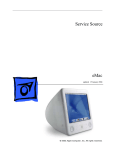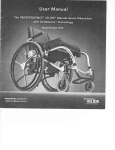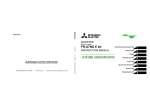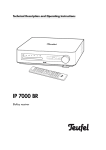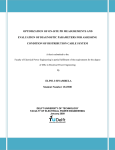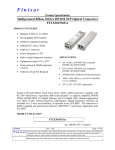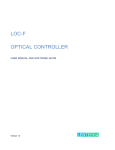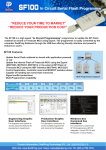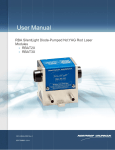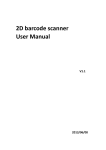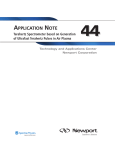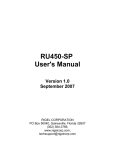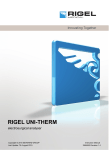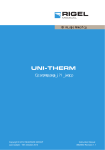Download Rigel 1550 User Manual
Transcript
Rige el 155 50 Teraherttz Spe ectrom meterr er Manual Use [email protected] Contents 1. System Description Overview Part Names Operating Conditions Start-up Procedure 2. Safety Laser Safety Electrical hazards CE compliance 3. Installation How to Install Sensors heads and connect to Spectrometer How to Restore Terahertz Signal Data Acquisition for Fast Scan Installing Drivers for the DAQ and Spectrometer Software 4. Spectrometer Operation Running Rigel 1550 Spectrometer Software Comparing Spectra Running FAST SCAN Calculating Absorption Coefficient Zero Padding Option Accessories Exiting and Shutdown of Spectrometer Rigel 1550 Terahertz Spectrometer User Manual 3 3 3 7 7 9 9 9 10 10 10 11 13 15 16 16 23 26 30 31 31 32 2 [email protected] System Description Overview The Rigel 1550 Spectrometer is a versatile instrument operating in the terahertz range. Rigel 1550 spectrometer is a portable, modular, compact, and reconfigurable terahertz time-domain spectrometer system capable of testing solid, powder, thin film, gas, and liquid samples for material sensing and characterization applications. The fiber coupled movable transmitter and receiver heads can be mounted around the sample or process under test, for the cases where bringing the sample or process under test inside the spectrometer housing is not feasible. The terahertz transmitter and detectors are driven by a Femtosecond fiber laser at 1550 nm. Part Names Figure 1 shows the main components of the front and back of Rigel 1550 terahertz spectrometer. 1. Optical Delay module 2. Onefive ORIGAMI Femtosecond Laser 3. Shaker electronic controller 4. Laser driver 5. Linear stage for slow scan 6. Lock-in amplifier 7. NI DAQ for data acquisition 8. Square wave generator 9. USB Hub 10. Shaker power supply Rigel 1550 Terahertz Spectrometer User Manual 3 [email protected] (a) (b) Figure 1 Main features of Rigel 1550 Terahertz spectrometer: (a) Front panel and (b) Back panel. Rigel 1550 Terahertz Spectrometer User Manual 4 [email protected] Figure 2 Rigel 1550 0 Spectromeeter Head fo or Transmisssion-mode THz-Time domain Spectrosscopy (TDS)). Rigel 155 50 spectrom meter has optiical light dellivery system m that includdes an opticaal delay box for slow and d fast teraherrtz scan. Thee slow scan can c be used to find the T THz signal ppeak and scann over long ger ranges, lo onger distan nce between transmitter aand receiverr with less nooise or high signal to noise ratio. The fast scaan option alllows for alm most real-timee measurem ment of changges when a sample is plaaced in the THz transmisssion mode uunit or the usser puts in thhe THz ver moduless in the path of a processs outside the spectrometeer head. transmittter and receiv Rigel 155 50 Terahertz z Spectrometer User Manual 5 [email protected] (a) (b) Figure 3 Rigel 1550 Spectrometer Head for (a) Reflection-mode and (b)ATR THz-Time domain Spectroscopy (TDS). Rigel 1550 Terahertz Spectrometer User Manual 6 [email protected] Operating Conditions Eectrical requirements: 100-240 V; 50-60 Hz, <5 A Operating temperature: 15 - 35°C Storage temperature: -15° - 65°C Humidity: < 50% Warm-up time: 10 minutes for laser emission Start-up Procedure CAUTION Do not turn the power to the instrument on and off quickly as this may cause damage to the units and power supply 1. Open the sample compartment spectrometer head and make sure there is no sample in sample holder and place sample holder in the center. 2. Make sure the THz Beam path between transmitter and receiver modules is free from obstructed. 3. Connect the power supply, the fiber optic cable for the Transmitter (Blue) and the other to the receiver (Red), one SMA connection labeled Tx to the Transmitter and the other SMA connection to the output from the receiver module. 4. Connect the USB from your Laptop or computer to the USB connection on side of the spectrometer cabinet for electrical components. 5. Turn the FAST SCAN OFF and POWER ON and green light comes on and the spectrometer is ready for use. Rigel 1550 Terahertz Spectrometer User Manual 7 [email protected] 6. Turn the key for the laser to On position and wait till the status LED stops blinking and has stable green light. Then press Emission button until it turns red light. 7. Wait until Windows recognizes the instruments and initialization is complete. 8. Run the Rigel 1550 Spectrometer Software to do a scan and find the THz peak signal before fast scan or simply conduct a slow THz scan using the spectrometer. Rigel 1550 Terahertz Spectrometer User Manual 8 [email protected] Saafety Laser Safety S Rigel 155 50 spectrom meter transmiitter and receiver are driiven by Fibeer-coupled fe femtosecond laser from Onefive. Oneffive’s ORIG GAMI is a Class C 3B las er. If user opens opticcal delay moodule, direct an nd mirror refflected high--peak-powerr, invisible liight pulses ccan be hazarrdous to eyees. If fiber is disconnected d or the opticcal delay mod dule open, thhe laser pow wer emitted bby the ORIG GAMI may cause retinal orr corneal daamage. The skin of thee human boddy can seveerely be dam maged when ex xposed to th he radiation n. Thereforre, extreme care shouldd be exerciised during laser operation n. User doees not need to eye-weaar during noormal operattion of the Rigel 1550 THz spectrom meter. xposure of th he eye to the invisible lasser beam muust be avoideed. Direct ex DAN NGER AVOID EYE E AND SKIN S EXPO OSURE TO O LASER R RADIATION N RADIATION OF THE ORIGAMI IS INVISIB BLE AND IN N FIBER AND DO O NOT DISC CONNECT THE TX A AND RX FIB BERS. Electriccal Hazard ds ntain electriccal circuits, ddevices and componentss operating aat The Rigeel 1550 specttrometer con high volttages. Contacct with thesee circuits, deevices and coomponents ccan cause death, serious injury, orr painful elecctrical shock k. Good grounding is esssential to avvoid a potenttially seriouss electric shock s hazard d. Applicatio on of the wro ong supply vvoltage can ccreate a fire hazard and potentially serious sh hock hazard, and could seriously s dam mage the Riggel 1550 speectrometer a any attacched equipm ment. system, and CAUTIO ON Do NOT T use powerr cords with h faulty or ffrayed insullation. Rigel 155 50 Terahertz z Spectrometer User Manual 9 [email protected] CE compliance The Rigel 1550 spectrometer and sensor heads have been designed to comply with the requirements of the Electromagnetic Compatibility (EMC) Directive and the Low Voltage Directive or LVD of the European Union. Installation How to Install Sensors heads and connect to Spectrometer WARNING Do not disconnect the fiber and MMCX cable from the Rx and Tx sensor heads. 1. The Transmitter and Receiver sensor heads come disconnected from the chassis of the Spectrometer. Both the optical fiber and electrical SMA connector must be connected during installation process. 2. Connect the Tx fiber (labeled as Tx) with one end already connected to the sensor to the collimator output (labeled Tx) on the chassis after passing the fiber through the hole on the top of spectrometer. The Tx is the middle Fiber output to the right of the Rx Fiber output. 3. Connect the Rx fiber (labeled as Rx) with one end already connected to the sensor to the collimator output (labeled Rx) on the chassis after passing the fiber through the hole on the top of spectrometer. 4. Connect the MMCX to SMA connector on Transmitter sensor to SMA cable from spectrometer electrical connections label Tx. The Tx and Rx output SMA cables pass through the hole at the top of the spectrometer. 5. Connect the MMCX to SMA connector on Receiver sensor to SMA cable from spectrometer electrical connections label Rx output. Rigel 1550 Terahertz Spectrometer User Manual 10 [email protected] How to Restore Terahertz Signal CAUTION The Transmitter and Receiver can be placed around any process under test or on optical breadboard but the shortest or minimum distance between the Tx sensor lens to Rx sensor lens is 17 cm. One can increase the distance between the sensor heads up to a distance of 47 cm. Ensure the polarization of the Tx and Rx sensor is correct by lining up the markers on the end-caps of the sensors. 1. Place the transmitter and receiver sensor heads in optical view of each other. The Tx and Rx should on the same level vertically and horizontally. The user has the option of placing the transmitter and receiver sensor heads around process or material under test but a breadboard is also provided for mounting the Tx and Rx on post. Figure 4 Rigel 1550 Terahertz Spectrometer Sensor Heads. 2. Conduct a long THz scan using Rigel 1550 Software by setting motor speed to 0.5 mm/s and scan range from 0 to 20mm. Follow the instructions on Running Rigel 1550 Spectrometer Software to conduct slow THz scan. If you do not find the THz peak and signal in this range change the delay in increments of 20 mm (from 20 mm to 40 mm) until you find the right delay for the THz peak. Rigel 1550 Terahertz Spectrometer User Manual 11 [email protected] 3. Once the THz signal is obtained on the time domain graph, the software automatically finds the THz peak and goes to the optical delay position for that THz peak. 4. The next step involves the maximizing the THz peak signal. In order to do that launch Show Peak THz Signal application that shows the signal level in real-time for the current delay position. 5. To improve the alignment the Tx and Rx sensor heads should be tilted along y-axis ( zaxis being optical axis) one by one to maximize signal ensuring the polarization is the same. The direction of the enclosure of the Tx and Rx antenna must be changed along the plane made by the marker for the polarization and the optical axis. 6. Then change the delay, after adjustment and changing the direction of the antennas, to maximize the THz signal reading. The delay can be changed by entering the position in mm for start position and going there by clicking GO START POSITION. The new position should be close to the peak position. 7. Repeat process by doing Steps 6 and 7 for finer alignment and should get a value for THz signal around 6. Rigel 1550 Terahertz Spectrometer User Manual 12 [email protected] Data Acquisition for Fast Scan The Rigel 1550 terahertz (THz) Spectrometer has fast scan option for conducting fast scan with setting of 1 Hz or one waveform per second. The waveform scan length is 50 ps and step size is 50 fs. By selecting the Fast Scan button and clicking START SCAN button in Rigel 1550 spectrometer software followed by turning on the FAST SCAN switch on the cabinet for the electronic housing one can do fast scan. CAUTION Before selecting the Fast Scan option make sure the lock-in setting in the Rigel 1550 Spectrometer software is set to sensitivity of High Dynamic mode and with 12 dB/Oct filter setting and time constant of 3 ms. The display range scaling should be the value of the sensitivity for example 1E-3 for 1 mV gain setting. For continuous real-time fast scan and data acquisition (DAQ) after doing one fast scan in main window of Rigel 1550 spectrometer software and switching on the FAST SCAN switch on the cabinet of the electronic housing run the DAQ FAST Real-time program. The DAQ FAST Real-time use a data acquisition of the analog THz signal from lock-in amplifier with a sampling rate of 20 kSamples/second on each channel and is used in acquiring one waveform per second and displaying the terahertz signal and spectrum. The DAQ has capability to go up to 100 kS/s per channel. The spectrometer comes with 4 slots for use of DAQ and is extendable for an array of terahertz transmitter and receiver modules. This is advantageous for industrial applications where an array of fiber-coupled terahertz transmitter and receiver sensor pairs are used to inspect an industrial process and the data is acquired in parallel. The DAQ FAST Real-time allows for any change in the path of the terahertz beam between transmitter and receiver such as putting a plastic or paper sample or any material to be observable in the delay of the terahertz signal, change in the amplitude of the THz signal and spectrum of the THz signal. Rigel 1550 Terahertz Spectrometer User Manual 13 [email protected] Nationall Instrumen nts DAQ tha at can be useed by Rigel 1550 Specttrometer sofftware Rigel 155 50 Terahertz z Spectrometer User Manual 14 [email protected] Installing Drivers for the DAQ and Rigel 1550 Spectrometer Software For Rigel 1550 Spectrometer Application (Rigel.exe) to work properly the user has to install the Labview Run –Time 8.5 and NI-DAQmx Device Driver 9.3 on your computer or Laptop. To install the Labview Run-Time 8.5: 1. Download the installation from the National Instruments (NI) website at http://www.ni.com/downloads/ 2. Run the application and follow the instructions. To install the NI-DAQ driver version 9.3 1. If you have other versions of the NI-DAQ on your computer, remove it and install the NIDAQ driver by running the NIDAQ930f2.exe that comes with Rigel 1550 Spectrometer and Rigel 1550 Real-Time terahertz signal acquisition tool. 2. Follow the instructions for the installation of the driver for the DAQ. Rigel 1550 Terahertz Spectrometer User Manual 15 [email protected] Spectrometer Operation Running Rigel 1550 Spectrometer Software After installing the drivers, connect the USB cable to the Laptop or computer and the operating system will detect the 4 devices connected using the USB cable. The cDAQ-9174 should be detected and the NI 9125 connected to it. The other three devices are the lock-in amplifier, Linear stage for the slow scan and shaker controller for the Fast scan. 1. Before running Rigel.exe to launch Rigel 1550 spectrometer software make sure the DAQ is connected and run a test using Measurement & Automation Explorer (NI MAX) to make sure the DAQ is connected. Select Configure and Test This Device below. 2. Right click on the NI 9125 (BNC) that is highlighted and run Self-Test and the program returns a message saying “The device passed the self-test”. The click on Test Panels at the top of the window and you should see the screen below: Rigel 1550 Terahertz Spectrometer User Manual 16 [email protected] Rigel 1550 Terahertz Spectrometer User Manual 17 [email protected] 3. Click Start to run the DAQ and make sure there is a signal on the screen then click on Stop then Close. Now DAQ is ready to use in Rigel 1550. Note: Make sure the name of the Channel is as shown on the screen image above. Rigel 1550 Terahertz Spectrometer User Manual 18 [email protected] Launch Rigel 1. Run Rigel.exe from the Rigel 1550 Spectrometer folder. 2. Adjust the screen to fit window of your Laptop or Computer. Rigel 1550 Terahertz Spectrometer User Manual 19 [email protected] 3. Scroll down to screen with Tabs and select Settings Tab. The Lock-in Settings, Linear Stage settings and Fast Scan settings are as shown below: Rigel 1550 Terahertz Spectrometer User Manual 20 [email protected] The setting for the lock-in Time constant is 100 ms and the Sensitivity is 300 µV. For the fast scan and other normal scans the Delta t or time resolution of the scan is 50 fs or 0.05 ps. 4. Click on GO HOME. 5. Under Scan Options after scrolling up enter the Start Position in mm, Scan Width in mm and Motor speed in mm/s for the normal scan. The Stop position is automatically calculated so it does not have to be entered. For example for the position of where the Tx and Rx are located. We do a scan for the delay starting at 20 mm and for 5 mm scan with a motor speed of 0.1 mm/s. This corresponds to a 33.3 ps scan. Rigel 1550 spectrometer returns the time domain signal, spectrum, peak position in mm, Full-width half maximum (FWHM) of the pulse, and the THz power spectrum bandwidth, which is 20 dB above the noise floor. The pulse width of our measurement in free-space for a large-aperture transmitter and 5 µm dipole as receiver is 1.3 ps and bandwidth of 0.93 THz. Rigel 1550 goes to the peak position automatically after each scan. Note: When clicking Start Scan for the first time the Shaker controller and motor for it is turned on and comes to center position affecting delay by 5 mm. The “is connected to uP?” LED lights up when servo motor is on and goes to center position for fast scan (if FAST SCAN is turned on the servo motor for the Shaker will oscillate w.r.t. the center position). Rigel 1550 Terahertz Spectrometer User Manual 21 [email protected] 6. Click GO START POSITION 7. Make sure the Emission light on the Laser is ON before doing a scan. Once the motor finishes going to the Start Position, Click START SCAN then click Create New Scan. 8. Enter Filename for the Time domain signal to store and Spectrum to store as .csv comma delimited files. The filename contains the data and time of scan. Once you click OK the shaker is turned on for the first time scan and then the Running Button will turn on green. At the end of the scan we get the signal and spectrum shown below. 9. One can do repeated measurements by putting a sample in transmission mode between the transmitter and receiver and doing the scan over the same range to see delay of the pulse and effect on the spectrum or changing the start position of the scan with the same scan width to measure and store the time domain signal and spectrum for post-processing and comparison. Note: The value of 6V THz signal corresponds to 6V/10V × 300µV × 1 µA/V Gain = 180 pA THz current on Rx antenna. Rigel 1550 Terahertz Spectrometer User Manual 22 [email protected] Comparing Spectra After finding the delay and obtaining the THz pulse using procedure of initializing and running Rigel 1550, put the sample in between the transmitter and receiver. To compare the spectra first put sample at focus of the transmission module or if using the collimated beam between Tx and Rx, put sample in the middle. For example here we compare the scan of ABS plastic sample. 1. After putting the sample in between the terahertz sensors, conduct a scan over the same range from 20 mm to 25 mm with a speed of 0.1 mm/s. The resulting time domain signal and spectrum are shown below. Rigel 1550 Terahertz Spectrometer User Manual 23 [email protected] It is shown that the pulse is broader from 1.3 ps in freespace to 1.5 ps with the ABS sample and the peak position shifted to 23.08 mm. The is also attenuation due to the sample. 2. To compare the spectra with other measurements or for this example the reference click on COMPARE. Select the file to compare which is a time domain scan csv file. Do not load the spectrum as the only time domain signal csv file is used to compare the signal and spectrum. Rigel 1550 Terahertz Spectrometer User Manual 24 [email protected] The Reference is loaded in red and the ABS sample measurement is in white shown below. The change in FWHM of pulses and 20-dB bandwidth above noise floor is shown too. Rigel 1550 Terahertz Spectrometer User Manual 25 [email protected] There is a clear difference in the spectrum and delay in the pulse in the time domain. Here again the ABS sample is shown in white and the reference air measurement shown in red. If you click clear comparison graphs it will clear the loaded signal and spectra to compare and shows the last scan which is in white line. Note: For convenience one can scan the sample first and store the data and do a reference measurement in air next to show the reference in white line as last scan. The data for the samples are then loaded using COMPARE from the stored data and shown in color such as red. Running FAST SCAN The fast scan option uses a sine wave generator with position voltage ranging from -1.5 V to 1.5 V and frequency of 1 Hz. The Fast scan acquires a waveform every 500 ms using this setting. The sine wave generator that drives the shaker servo motor can be increased to 20 Hz. Rigel 1550 Terahertz Spectrometer User Manual 26 [email protected] To run Fast scan mode , first load Rigel.exe for normal slow scan mode and get the signal using the Rigel 1550 spectrometer software as outlined above. Rigel 1550 spectrometer automatically goes to the peak position. Then follow the following steps: 1. Change the Time constant of the lock-in amplifier under Lock-in settings to 12 dB/ Oct. 3 ms as shown below. The unlocked led light turns on if the signal is unlocked if reference is disconnected. The overload turns on if the gain is high. But the Signal to Maximize should show a signal between range of -10 V to 10 V with display range scaling of 1e-3. If the signal is within this range the DAQ is working and the lockin is not overloaded. 2. Turn the FAST SCAN manual switch at the side of spectrometer ON 3. Run RigelRealTime.exe NOTE: The Main Rigel.exe application program must be running with the lock-in settings mentioned above for the real-time signal and spectrum to show in the Rigel 1550 Real-Time application. Rigel 1550 Terahertz Spectrometer User Manual 27 [email protected] The Figure above shows the real-time signal and its spectrum after running RigelRealTime application. If a sample is placed between the transmitter and receiver, the change would be shown in real-time or in a matter of ms. The Data tab shows the setting for Delta t which is 50 fs, the number of waveforms to average is set to 1 for fast scan and up to 5 to average out the noise. Since a 3 ms time constant averages out Rigel 1550 Terahertz Spectrometer User Manual 28 [email protected] the noise at that speed, there might not be a need to average the waveforms for this setting but if the Fast scan is increased to 20 Hz this function is used to average the waveforms say up to 11 waveforms before showing the THz signal and spectrum. The X scale is a scale for the amplitude of the THz signal and it is set to 0.01. This scale is adjusted to view the THz signal to values of between -15 to 15 for sensitivity of 300 µV on the lock-in. 4. Click the STOP to stop the continuous data acquisition after doing measurements Rigel 1550 program will ask you to save the THz signal when you clicked STOP into a CSV file. Rigel 1550 Terahertz Spectrometer User Manual 29 [email protected] Calculating Absorption Coefficient 1. In order to calculate absorption coefficient of a material, first place material in transmission module or in between the transmitter and receiver and conduct a scan within the same scan range that you would use for reference scan in air 2. Check the checkbox on the right that is named Reference and run another scan removing the material and conducting an air scan within the same range. NOTE: Make sure the pulse for the reference is in the same scan range window as the material under test. 3. While the Reference checkbox is clicked, the last scan you did without a sample is the reference scan and will be used to compute the absorption coefficient by clicking COMPARE button. 4. Similar to the comparison of spectra, the software will ask the user to select the file name (Time domain csv file) of the material that was scanned in step 1 and show the absorption coefficient once the files is loaded in the Spectrum window. 5. To clear the graphs showing the absorption coefficient, click Clear Comparison Graphs. Rigel 1550 Terahertz Spectrometer User Manual 30 [email protected] Zero Padding Option Before a scan, one can select Zero Padded checkbox to zero-pad the time domain signal with the number of zeros equal to the Zero pad accuracy or default setting of 1024. The user can change the zero pad accuracy or number of zeros to add to the signal for zero padding before computing the spectrum for higher resolution by changing the Zero pad accuracy setting under the Bandwidth Accuracy Settings. Accessories The Rigel 1550 terahertz Spectrometer comes with a transmission mode measurement module for conducting spectroscopy of power samples compressed into a 13 mm diameter pellet or to put any sample at focus of terahertz beam. The terahertz transmission-mode measurement module uses two focusing lenses to focus the collimated terahertz beam from the transmitter module unto the sample with a beam spot size of 3 mm or less. The second focusing lens collects the transmitted beam through the sample and collimates the beam that is collected by the receiver sensor module. Unlike the case of putting a sample such as a large plastic in between the transmitter and receiver without the transmission-mode measurement unit where the collimated beam interacts with the sample, using the transmission-mode measurement unit focuses the beam to a sample spot size so the beam interacts with the sample over the small region such as the case for a 13 mm diameter pellet. The transmission-mode measurement unit also has two other positions to put the sample holder with the sample to have the sample interact with a slightly de-focused THz beam. Although the spot size at these locations is not at focus, the beam spot sizes are smaller than the case for the collimated THz beam. Rigel 1550 Terahertz Spectrometer User Manual 31 [email protected] Exiting and Shutdown of Spectrometer 1. 2. 3. 4. 5. Turn the Emission red button on the laser off. Press Quit button in Rigel 1550 Terahertz Spectrometer software. Unplug the USB connection to the Spectrometer Turn the key on the laser to switch OFF the laser. Turn the Green button for the Spectrometer OFF. Rigel 1550 Terahertz Spectrometer User Manual 32 [email protected] Contacts TeTechS Inc. 295 Hagey Blvd., 1st Floor Waterloo, Ontario N2L 6R5 Canada Toll Free: +1 (855) 574-1764 Tel: +1 (519) 584-0791 Fax: +1 (519) 513-2421 www.tetechs.com Email: [email protected] © TeTechS Inc. 2014 Rigel 1550 Terahertz Spectrometer User Manual 33

































